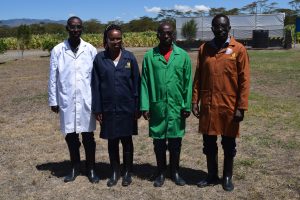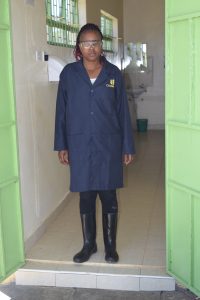MLN Screening Facility Phytosanitary Regulations
MLN Screening Facility Phytosanitation Guidelines
The International Maize and Wheat Improvement Centre (CIMMYT) together with the Kenya Agricultural and Livestock Research Organization (KALRO) established a MLN Screening Facility at Naivasha, Kenya, in September 2013 to enable identification of maize germplasm with tolerance/resistance to MLN under artificial inoculation. This facility is now central to screening maize germplasm from both public and private sector institutions in Africa, and is critical in our ongoing efforts to effectively tackle the challenge of MLN. The facility provides a quarantined and regulated environment to screen the germplasm to develop the MLN resistant varieties to combat the disease.
Please contact Dr. Suresh, L.M., (l.m.suresh@cgiar.org ) scientist in charge of the program for further instructions and procedures.
Objective:
Deliver and implement sanitation guidelines that are specific to the MLN Screening facility and quarantine site in Naivasha to ensure the desired level of insect and pathogen control that is essential for successful research.
Guidelines:
No unauthorized persons will be permitted access to KALRO/CIMMYT MLN screening facility.
Authorized CIMMYT and other personnel access requirements.
- Visitors to the MLN screening/quarantine site will be strictly regulated. Prior authorization by CIMMYT- GMP Program Director or MLN research station lead person will be required.
- Avoid visiting the MLN screening/quarantine site. Persons entering the MLN quarantine site are not to visit any other maize field on the same day after visiting the quarantine site.
- All persons working in the MLN screening/quarantine site will be required to change clothes and shoes prior to leaving the site. Used field clothes and shoes will be stored in sealed plastic bags and promptly laundered or cleaned.
- Do not take seed or other plant parts or soil from the field or storehouses.
- Taking food, gums, drinks and use of tobacco products inside the facility is strictly prohibited.
- Workers assigned to specific greenhouses must work in the same notified area and direction every day.
Plant materials handling (Process and Materials):
- Employees and visitors, if they are carrying plant and plant materials from the crop area or green house, are required to dispose the plant and plant materials in the waste bin.
- Plant material (seeds) from outside must to be tested for risky pathogens before planting them in KALRO/CIMMYT facilities. It should be considered as quarantine material until its phytosanitary status is verified.
- Employees and visitors carrying plant and plant materials from the crop area or green houses for disease diagnosis purposes are required to submit the samples in a covered bag with necessary details.
- All disease free seeds are only taken for MLN screening from various partners after due confirmation.
- No plant materials or seeds will be allowed out of the facility before, during and after the experiments.
- There is no selfing or Hybrid seed production is done in this screening facility.
- All the materials including those used during the experiment will be incinerated after the experiment is completed with prior confirmation.
Facilities and Equipment:
Equipment and Tools
- Do not let watering nozzles or hand tools contact greenhouse floors. Greenhouse floors can serve as a reservoir for pathogens. Place tools on carts or benches.
- Hand tools assigned to a specific greenhouse cannot be used in any other greenhouse. This will limit the movement of pathogens should a disease outbreak occur.
- Wash hand tools after use to remove all soil and plant sap from tool surfaces and thoroughly wet all exposed tool surfaces by spraying with a 1% solution of Sodium Hypochlorite.
- Field equipment used during the MLN season will be designated for use only at the quarantine site as well as screening facility. Field equipment will be cleaned and inspected prior to storage.
- Use 10% TSP or chlorine water solution or alcohol to wash or disinfect all equipment or instruments used in the field, before returning them.
Environment / Water :
- Wash your hands after your assigned / notified sowing, planting, inoculation and observation.
- Do not let used water flow around the green house premises.
- After the observation, used plant and plant debris should be disposed using the notified practices.
- The pathologist may restrict access to the greenhouse based on visual symptoms of the plant where the sample was collected to prevent spread of disease.
Vehicle policy:
- Vehicles will not be permitted within the isolation distance required (100 meters). Workers, visitors and vendors will not be permitted to enter vehicles prior to changing clothes and shoes after working in the quarantine site.
- Wash and disinfect inside and out of the vehicles used in the field before traveling to MLN screening facility.






